This was published 11 months ago
Behind the million-dollar smile, Luna Park hides a troubling story
Prime harbourside land, court feuds and circling developers. This is the very Sydney story of one of the city’s most iconic landmarks.
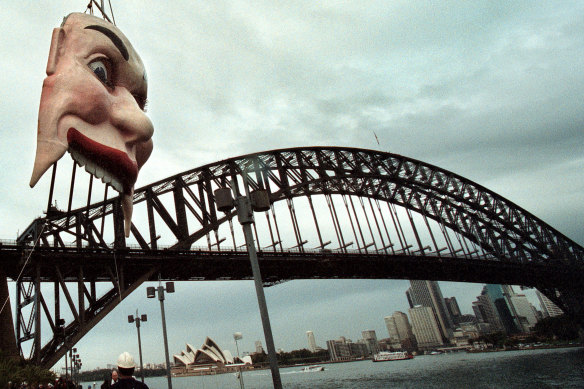
The Face at the entrance to Luna Park being removed in 2001 during the dismantling of the second Big Dipper, which was sold to Dreamworld after a court fight.Credit: Rick Stevens
Face lifts, court fights and developers vying for prized public land by the harbour might sound like just another day in the emerald city. But it’s also the story of one of Sydney’s most recognisable landmarks.
Luna Park, the art deco-era theme park whose grinning entrance by the water at Milsons Point has been reinvented eight times, has been listed for sale for the first time in decades. Expressions of interest in the long-term lease of the park on Crown land close in August.
The heritage-listed amusement park has entertained generations of Sydneysiders, but it also has a tortured history of planning, political and legal scuffles, and it bears the scars of the tragic ghost train fire in 1979, which killed six boys and a father.
In 1969, plans for a multimillion-dollar redevelopment of the site as a high-rise “international trade city” were revealed by the park’s then leaseholder. It did not receive the green light.
The prospect of high-rise redevelopment loomed again in March 1989 when The Sydney Morning Herald published leaked plans from a new lessee, obtained by the NSW opposition, showing a hotel and office tower on the site.
By November 1989 the North Shore Times was reporting Luna Park was “safe” and high-rise was “officially out”. The next election was in May 1991.
“Luna Park is a landmark site,” then premier Nick Greiner reportedly said. “You don’t have to be a raging greenie to work out it’s a once-only site.
“We want to try and find an outcome which preserves Luna Park, gives public access along the foreshore ... and at the same time allows some development.”
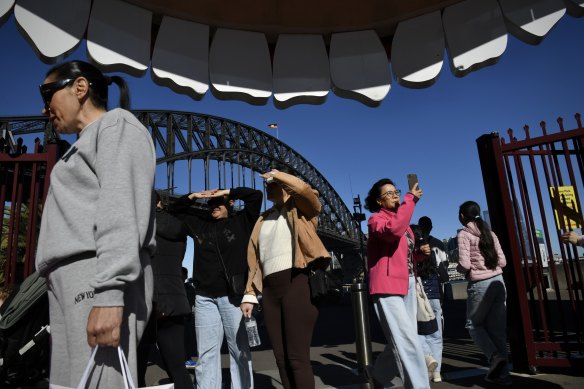
The foreshore seen through the famous grin on Sunday. Credit: Dean Sewell
The Greiner Liberal government tore up the Luna Park lease in 1990, after the then operators failed to meet a June 1 deadline to reopen the park following renovations. It set up a trust to take control of the Crown land, dedicated for public recreation, amusement and entertainment. Turning the site into parkland was mooted if a theme park proved unviable.
The Luna Park precinct was listed in 2010 on the state heritage register, which provides additional protection.
Among the most publicised fights over the site have been court feuds over new rides, including the 1990s iteration of the Big Dipper – installed as part of Luna Park’s bid to compete with the now-defunct Australia’s Wonderland, then home to the Bush Beast and Demon roller coasters.
But there have also been broader contests over how the Crown land should be used, and who profits.
The Big Dipper
The arrival of the giant steel Big Dipper in 1995 – the wooden original was demolished in the 80s – sat uneasily with local landowners, as mechanical noise and thrillseekers’ screams floated through the air every Friday night and all weekend. The park had reopened in January that year, and the roller coaster was expected to run seven days a week in school holidays.
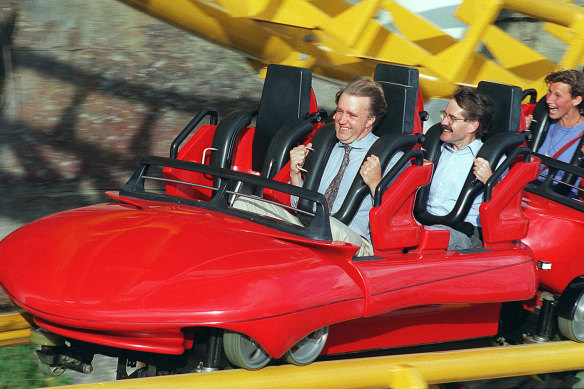
Des Wittingslow of Wittingslow Amusements on The Big Dipper in 1995.Credit: Robert Pearce
Acclaimed architect Harry Seidler joined a developer-led court action by residents and property owners to have the ride shut down on the basis that it was a nuisance – a legal term of art for substantial interference with the use and enjoyment of property.
Glen Street in Milsons Point is home to a trio of Seidler-designed and owned buildings that sit atop a cliff at the eastern boundary of Luna Park, including the Seidler & Associates architectural offices and adjoining two-storey penthouse apartment. North Sydney Council’s then-new zoning laws required two of these three office buildings to have some residential units, and the buildings were completed before the arrival of the new Big Dipper.
In September 1995, Supreme Court Justice David Hodgson upheld the case against the Luna Park Reserve Trust, a state government entity that entered into a short-lived joint venture with private carnival operator Wittingslow Amusements.
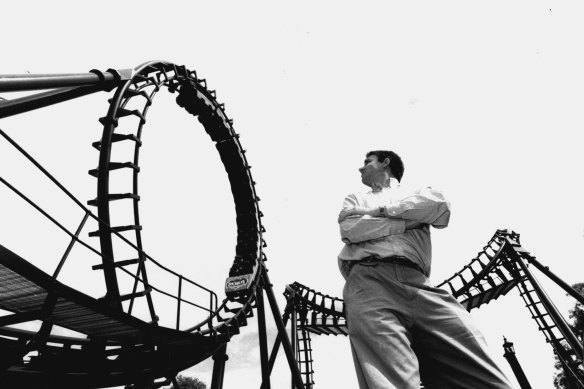
The Demon roller coaster at Australia’s Wonderland, pictured in September 1992.Credit: Steven Siewert
The trust had insisted a large roller coaster should be the key attraction at the reimagined Luna Park, but Hodgson noted Wonderland’s Eastern Creek site was “well removed from residential areas” while Milsons Point was “now significantly residential”.
Hodgson said the trust had “assured residents ... the new roller coaster would be half as loud as [the] original Big Dipper”, but it was in fact louder and much taller, bringing the source of the noise closer to offices and units. It was about twice as loud as its immediate predecessor, the Jet Star, and “in places nearly three times as loud as the trust had undertaken to make it”.
The judge did not shut the ride down, and said he wouldn’t have found it was a nuisance if it didn’t have “a significantly greater impact on the neighbourhood” than previous roller coasters. Instead, he restricted its operation to Friday nights and all day Saturday until 11pm. The restrictions were to remain until the noise was reduced.
The park closed again in February 1996.
Harry Seidler, who died in 2006, said in a letter to The Australian in April 1996 that he was “a founding member of the Friends Of Luna Park group which sought to get the park reopened” and had “always supported the retention of Luna Park”.
The Ranger
In 1999, the state government announced a new group, including the owners of Sydney’s Metro Theatre, would redevelop and operate Luna Park.
Metro Edgley, acquired by construction giant Multiplex in 2002, said in a 2001 development application that the Big Dipper would be removed in a “deliberate and symbolic gesture of goodwill”. It was sold to Dreamworld that year.

The Ranger, pictured at Luna Park in 2005.Credit: Ben Rushton
A redeveloped Luna Park with a 3000-capacity Big Top for events reopened in April 2004 under a 40-year lease, after short stints between New Year’s Eve 1999 and 2001.
But a fresh standoff with a new group of residents and a property developer was brewing over noise from rides.
Their Supreme Court lawsuit, launched in 2005, was reformulated after the then Labor government took the extraordinary step of killing their claim by passing a law shortly before the trial was due to start which provided that noise emissions from Luna Park did not constitute a nuisance.
The re-worked case instead focused on adult thrill rides, including the Ranger, and alleged they were situated in a section north of Coney Island in contravention of a 1998 plan of management.
The plaintiffs also alleged Metro Edgley engaged in misleading and deceptive conduct by not revealing in development applications that it would put the rides in that spot.
Justice Paul Brereton dismissed the case in 2009. He said the plan of management did not exclude adult thrill rides in that area and the DAs were not misleading or deceptive, although Metro Edgley had told “half the truth” at a meeting when it said it would put children’s rides in that location.
Hair Raiser
The Hair Raiser, which elevates the brave to the top of a 38-metre tower before dropping them sharply to earth at more than 80 kilometres per hour, opened at the park in late 2013. It also raised the ire of locals.
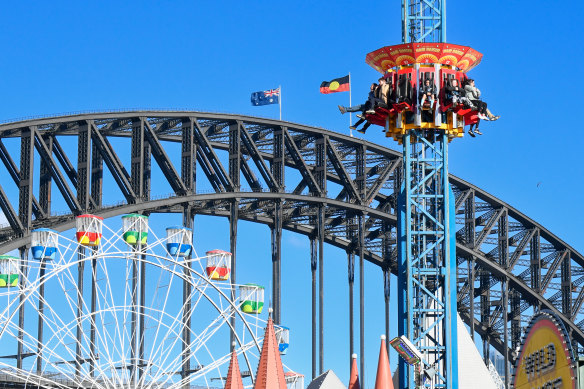
The Hair Raiser at Luna Park, pictured in July this year.Credit: Peter Rae
Luna Park believed the ride was legally erected but the NSW planning department did not share that view. The department sought to have the ride demolished.
Ultimately, the precursor to the state’s Independent Planning Commission determined in 2015 that the continued use of the ride should be approved, with a condition aimed at reducing its visual impact. It said the Hair Raiser was “no noisier than other rides” and met specified noise limits.
Flying Carousel
In 2018, the NSW Land and Environment court ruled the park could not install a new ride, the Flying Carousel, without a separate planning approval.
The park at the time said the decision “places a big question mark” over its “long-term viability”. But Luna Park subsequently introduced a series of new rides under relaxed planning controls. Volare, the flying carousel, debuted in 2019.
The sale
The Canadian Brookfield Asset Management took control of Luna Park when it bought Multiplex in 2007. A new Big Dipper opened on Boxing Day, 2021.
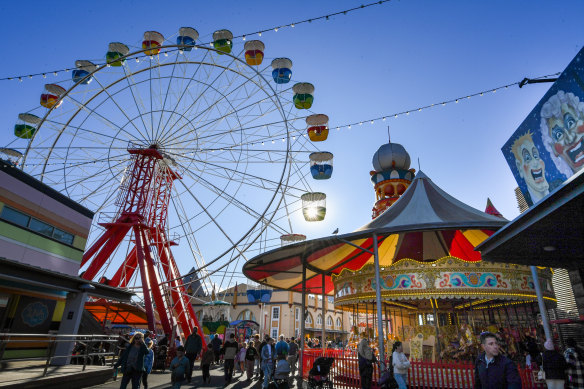
Brookfield, which controls Luna Park Sydney, announced in June that it was selling the 40-year lease of the park.Credit: Peter Rae
Brookfield announced in June that it is selling the business including 40-year leases of the theme park and boardwalk, which are due to expire on August 1, 2044. An incoming buyer would likely seek an extension.
UP FOR SALE
- Luna Park lease: 40 years expiring August 1, 2044 (includes the amusement park);
- Boardwalk lease: 40 years expiring August 1, 2044;
- Car park lease: 99 years expiring August 19, 2103.
Luna Park’s 99-year underground car park lease, which expires on August 19, 2103, is also up for sale.
Fierce debate
Luna Park has long sat at the centre of a fierce debate about how Crown land should be used. In 1997, the then Labor government amended the Luna Park Act to allow a wider range of uses on the site. This included a prime clifftop site in Glen Street, Milsons Point, above the theme park. Hotels, car parks and offices would be permitted in that area, but heritage-listed fig trees were safe.
At the time, the failed 1995 reopening of the park was raw. The NSW auditor-general said in an October 1995 report that although it was “ill-suited and ill-equipped, and had no intention to do so”, the state government had been “involved in running an amusement park”, costing tens of millions of dollars.
The government said the changes would help ensure Luna Park could be “funded by the private sector at no cost to the government”.
Against that backdrop, a December 2002 agreement between the trust and the Multiplex-controlled Luna Park Sydney contemplated not only a lease of the main park site but three adjacent sites on Crown land where commercial development would be allowed, including the prized clifftop area. Eventually, the latter sites were leased for 99 years for $1 each.
Each of the sites is part of the Luna Park zone but sit outside its main strip, which is covered by the shorter 40-year lease.
A Seidler family company paid Luna Park Sydney $5 million in 2006 to forgo its plans for a multi-storey office building on land covered by one of the 99-year leases, on the clifftop site next to Seidler’s office building overlooking Luna Park. It also paid the bulk of the costs associated with the design and construction of the public Harry’s Park, completed in 2011.
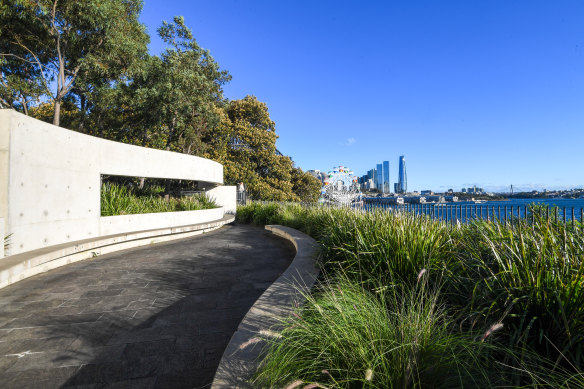
Harry’s Park in Glen Street, Milsons Point, completed in 2011 and pictured in July this year.Credit: Peter Rae
In 2016, the Perrottet government agreed to pay Luna Park Sydney a further $3.2 million to forfeit its lease of a neighbouring part of the clifftop site, which had been slated for development as a restaurant. It became Northcliff Park, opened in 2019.
The Multiplex group built the commercial building Milsons Landing, also in Glen Street, on land covered by another 99-year lease granted under the Luna Park deal. It has since sold office suites in the development. The third lease, the car park, is included in the Luna Park sale.
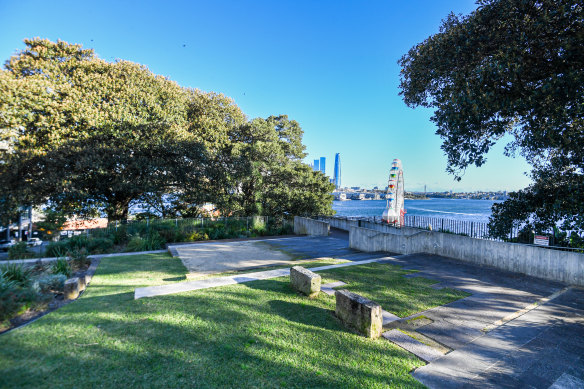
Northcliff Park, next door to Harry’s Park, was once slated for a restaurant.Credit: Peter Rae
North Sydney councillor Ian Mutton, a Milsons Point resident, said:“Luna Park, over the years, has been a giant Magic Pudding for investors.
“Each time there’s been a change of ownership the government has either contributed to the value with either cash or the long-term lease of adjacent land that’s later been transferred to related parties at peppercorn prices.”
Mutton said that “if the Magic Pudding is again being called upon, it can only be hoped it is used to protect all of the heritage rides that are the magic of this iconic park”.
But a Luna Park Sydney spokesman said that “we are incredibly proud of the more than $140 million Luna Park has invested on this site during the past two decades, which has benefited the state and its residents”.
“This investment has contributed to Luna Park Sydney being a vibrant and thriving amusement park that welcomes more than 1.1 million visitors every year and provides employment for over 700 people.”
Former Friends of Luna Park spokesperson Genia McCaffery, who was North Sydney mayor for 17 years, said the park’s identity and operations had strong legislative protection. There was currently “nothing happening to raise our concerns”, she said, such as moves to reduce heritage controls.
“If that happened, people would be out there and demonstrating against it,” McCaffery said. “It’s popular; people love it. It’s a big symbol of Sydney.”
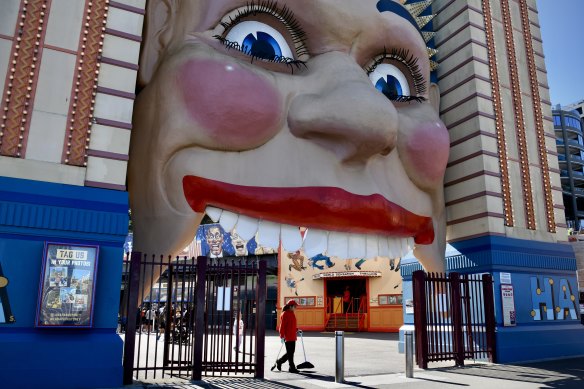
The iconic Luna Park face in Sydney.Credit: Dean Sewell